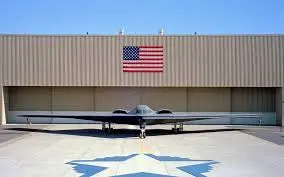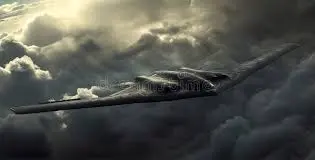In the high-stakes world of modern military technology, very few machines have inspired as much awe, fear, and intrigue as the B-2 Spirit bomber. Often dubbed “The Stealth Bomber,” the B-2 isn’t just an aircraft — it’s a symbol of invisible power, a ghost in the sky that can strike without warning and vanish without a trace.
From the eerie shape of its bat-like wings to its mysterious black coating, the B-2 Bomber has long captured the imagination of civilians and militaries alike. But beyond its menacing appearance lies a masterpiece of engineering that fundamentally changed how nations approach warfare and defense.
So what makes the B-2 Bomber so iconic? How does it work? Why is it still relevant after more than three decades in service? And what role does it play in today’s shifting global military landscape?
Let’s dive deep into the story of the most elusive aircraft in modern history.

The Birth of a Phantom
The B-2 Spirit’s origins trace back to the Cold War, a time when the United States and the Soviet Union were locked in a seemingly endless arms race. The need for a long-range bomber that could penetrate deeply into enemy territory without being detected became more urgent as Soviet air defense systems grew increasingly advanced.
Northrop Grumman, a major defense contractor, answered the call with a design so radical it looked like science fiction. With its unique flying wing configuration and radar-absorbent materials, the B-2 was built from the ground up to be undetectable.
Its first public flight in 1989 was nothing short of legendary — a futuristic craft floating across the sky with no vertical stabilizers, no tail, and barely a sound. It was the birth of stealth aviation’s golden era.
Design: Built to Be Invisible
At first glance, the B-2’s silhouette seems alien. Its wide, flat, wing-like shape looks like it was plucked from a sci-fi movie. But every curve, every edge, and every surface of the B-2 has a purpose: to defeat radar.
The aircraft's “flying wing” design eliminates many of the surfaces that typically reflect radar waves, making it incredibly hard to detect. Coated in radar-absorbent material (RAM) and loaded with internal heat masking systems, the B-2 doesn’t just fly — it disappears.
Even the engine inlets and exhausts are concealed in such a way that they minimize the aircraft’s infrared signature. This level of invisibility allows the B-2 to fly into some of the most heavily defended airspaces on Earth — and leave without a trace.

Power and Performance: Speed Isn’t Everything
The B-2 isn’t built for speed — it’s built for stealth and reach.
Powered by four General Electric F118-GE-100 turbofan engines, the bomber can reach high subsonic speeds and operate at altitudes of over 50,000 feet. But what truly makes it a global threat is its range. With aerial refueling, the B-2 can reach virtually any point on the planet and return to its base without ever touching the ground.
It can carry up to 40,000 pounds of conventional or nuclear ordnance, including gravity bombs, precision-guided munitions, and bunker busters. Its internal bomb bays ensure that all weapons are stored without compromising the aircraft’s stealth profile.
Mission Capabilities: One Plane, Many Roles
Though it was originally designed for nuclear deterrence, the B-2 has proven itself as an incredibly versatile platform. Its first combat mission came in 1999 during the Kosovo conflict, when B-2 bombers flew non-stop from Missouri to Serbia, dropped their payloads, and returned — all without detection.
Since then, the B-2 has been used in various operations in Afghanistan, Iraq, and Libya, delivering precision strikes that paved the way for ground forces.
Its stealth capabilities mean it can be the first aircraft into a hostile area, softening targets before traditional fighters and bombers arrive. It’s the silent hand that turns the tide of war before the enemy even knows it’s there.
The Price of Perfection
All of this technology doesn’t come cheap.
When the B-2 program was first launched, the U.S. Air Force planned to buy 132 bombers. But as costs soared and the Cold War ended, that number was drastically cut. In the end, only 21 B-2 bombers were built, each costing around $2.1 billion (including research and development).
Yes, you read that right — $2.1 billion per aircraft.
Despite its price tag, the B-2 has earned its place as a priceless asset in America’s military arsenal. Its ability to strike anywhere at any time, all while remaining virtually undetectable, is unmatched even today.
Stealth Isn’t Invincibility
Although the B-2 is incredibly advanced, it's not invincible. In 2008, a B-2 crashed shortly after takeoff in Guam — the first (and only) total loss in the aircraft’s history. Fortunately, the pilots ejected safely.
The crash was later blamed on moisture in the aircraft’s sensors, which caused the onboard systems to misread airspeed and altitude.
The lesson? Even ghosts can fall when technology misfires.
That said, the overall mission success rate and reliability of the B-2 remain remarkably high — a testament to the engineers, pilots, and maintainers who keep these legendary machines airworthy.
Inside the Cockpit: Flying the B-2
Operating the B-2 isn't just about pushing buttons. The aircraft requires a highly trained crew of two pilots, who undergo extensive simulation training before ever taking the controls.
The cockpit is surprisingly analog compared to newer jets — a mixture of buttons, switches, and digital displays. But don’t be fooled — the systems beneath are highly sophisticated, capable of autonomously adjusting flight paths to maintain stealth and optimize fuel usage.
Pilots describe flying the B-2 as both “nerve-wracking” and “incredible.” Every mission is a high-stakes operation. Every second matters.
Strategic Relevance Today: Still a Threat in the 2020s
More than 30 years after its debut, the B-2 remains a cornerstone of U.S. strategic air power. In an era of drones, hypersonic missiles, and cyber warfare, why is a 1980s-era bomber still so critical?
Because no other aircraft can do what the B-2 does — sneak into enemy territory, bypass defenses, and deliver massive payloads with pinpoint accuracy.
As tensions rise with countries like China, Russia, Iran, and North Korea, the ability to project power without detection becomes increasingly important. The B-2 ensures that the U.S. can reach any target on Earth — and do so without warning.
The Future: B-21 Raider and the B-2’s Successor
Northrop Grumman is already working on the B-21 Raider, the B-2’s spiritual successor. With cutting-edge tech, enhanced stealth, and AI-assisted operations, the B-21 is set to continue the B-2’s legacy into the next generation.
But don’t expect the B-2 to retire overnight.
The Air Force plans to keep the B-2 in service until at least 2032, with upgrades to navigation, communication, and defensive systems already underway.
In many ways, the B-2 walked so the B-21 could fly. And together, they represent the future of stealth warfare.
Fun Facts About the B-2
- Nicknamed the “Spirit”: Each B-2 is named after a U.S. state, like the “Spirit of Missouri.”
- Stealth Coating: The bomber’s surface must be meticulously cleaned and maintained to preserve stealth.
- No Tail: The B-2 has no vertical stabilizer — a major contributor to its radar invisibility.
- Global Reach: B-2s have completed 44-hour round-trip missions, refueled mid-air multiple times.
- Hollywood Star: It’s featured in movies like Independence Day, Transformers, and Iron Man.
Conclusion: A Legend in the Sky
The B-2 Bomber is more than just an aircraft — it’s a statement. A symbol of dominance, strategy, and invisible force. From Cold War fears to modern global challenges, the B-2 has remained one of the most formidable tools in the U.S. arsenal.
Its sleek silhouette against the sky sends a clear message: you won’t see us coming — but you’ll know we were here.
And even as the future arrives in the form of B-21 Raiders and AI-powered drones, the legend of the B-2 Spirit will forever haunt the skies.